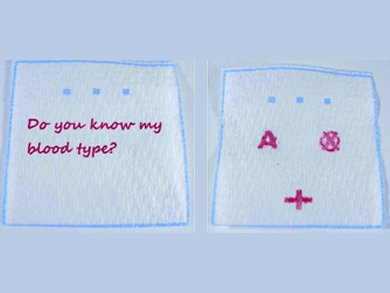As If By Magic …
In the book “Harry Potter and the Chamber of Secrets” by J. K. Rowling, Harry writes a question in Tom Riddle’s diary—and a written answer appears. Australian researchers were inspired by the idea of paper that writes on itself. In the journal Angewandte Chemie, they have introduced a blood test that indicates blood type in plain text.
Rapid tests made of paper are a simple and inexpensive alternative for diagnostic tests, particularly for use in developing nations. However, they are not completely uncomplicated, and a lack of expertise can lead to fatal misinterpretations. For example, if the wrong supply is used for a blood transfusion, it could result in death. A team led by Wei Shen at Monash University has now developed a “responsive” paper that indicates blood type as unambiguous text.
Blood Type Written on Test Paper
Like the conventional laboratory technique, this test is based on the fact that red blood cells agglutinate or clump together when they encounter antibodies directed against their antigens. The paper is printed with a hydrophobic layer with four windows left “open”. These windows contain the antibodies. In the windows containing the antibodies that correspond to the sample, the red blood cells agglutinate to form large clumps and get caught by the paper fibers, leaving behind a red tint even after washing with saline solution.
Currently, blood types are classified with the ABO system, in which designations of A, B, AB, and O are possible. The letter indicates which antigens are present on the red blood cells. Individuals with type A blood have type A antigens, those with type B have type B antigens; individuals with blood type AB have both types of antigens, those in the O group have no antigens. The system is also used to indicate whether the blood cells have rhesus factor D (RhD positive) or not (RhD negative).
So how does the paper “write” the blood type? For types A, B, and AB it is easy: Two of the windows are shaped like the letters A and B, and are filled with the antigens A and B, respectively. Type A results in a red tint in the A-shaped window, type B in the B-shaped window, and type AB in both. However, type O doesn’t respond to any antibody, so the researchers had to get creative. They made the third window in the shape of an X, included antibodies against A and B, and printed on a red letter “O”, which was printed with a waterproof ink. Blood types A, B, or AB turn the X red, telling the user that the sample is not O type by “crossing out” the O. If the sample is type O, the X becomes white after saline washing, leaving only the red letter O.
The researchers were equally clever in their approach to indicating whether the blood is RhD positive or negative: The fourth window is shaped like a vertical line and contains antibodies against rhesus factor D. A red horizontal line is printed on the paper with the water-proof ink. If the blood is RhD positive, it tints the vertical line red. In combination with the printed water-proof horizontal line, this forms a plus sign. If the blood is RhD negative, the vertical line becomes white after saline washing and the paper shows only a minus sign.
Image: © Wiley-VCH
- Paper-Based Blood Typing Device That Reports Patient’s Blood Type “in Writing”,
M. Li, J. Tian, M. Al-Tamimi, W. Shen,
Angew. Chem. Int. Ed. 2012.
DOI: 10.1002/anie.201201822




